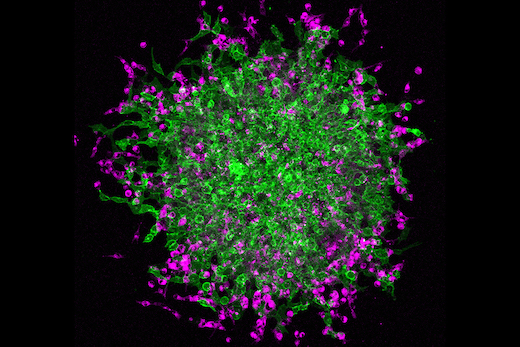What does it take to be a leader – of cancer cells?
Adam Marcus and colleagues at Winship Cancer Institute are back, with an analysis of mutations that drive metastatic behavior among groups of lung cancer cells. The findings were published this week on the cover of Journal of Cell Science, and suggest pharmacological strategies to intervene against or prevent metastasis.
Marcus and former graduate student Jessica Konen previously developed a technique for selectively labeling “leader” or “follower” lung cancer cells in culture, using lasers that turn a fluorescent protein from green to red. The leaders are more adventurous and invasive, but the followers support the leaders and help them survive. Check out our prize-winning video and their 2017 Nature Communications paper.

The magenta cells have leader-specific mutated Arp3 protein, while the green cells are unmodified followers.
The new research harnesses their technique to track the mutations that are specific to leader or follower cells. It was a collaboration with the lab of Paula Vertino, formerly at Winship and now at University of Rochester. Cancer Biology graduate students Elizabeth Zoeller and Brian Pedro led the work, with sophisticated genomics from Ben Barwick.
One of the leader-specific mutations was in Arp3, part of a protein complex that promotes the protrusion of cellular blobs, facilitating migration. The researchers took the mutated Arp3 protein from leader cells and forced its production in follower cells. In the cover image, the magenta cells on the outside are the ones with the mutated Arp3 protein, while the green cells are unmodified.
“Together, these data indicate that ARP3 K240R confers key leader-like behaviors onto follower cells, including increased invasive capacity, increased numbers of invasive chains and a greater ability to lead those chains,” the authors write.
Inhibitors of Arp3 are available, and inhibitors of other components of the pathway (Plk4) are currently under clinical investigation. The Winship researchers also analyzed a follower cell-enriched mutation in KDM5B, an epigenetic regulatory protein.
In a recent Twitter thread, Marcus speculates that “many of the mutations found in the ultra-invasive leader cells are not found in the bulk of the population” and bulk sequencing methods may miss them. Their previous work and the analysis in the JCS paper comes from a human lung cancer cell line in culture, but Marcus says his lab is moving to patient samples to look for rare metastatic cells.
About the author
Science Writer, Research Communications qeastma@emory.edu 404-727-7829 Office

